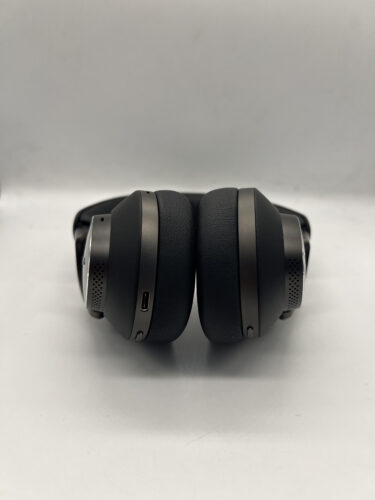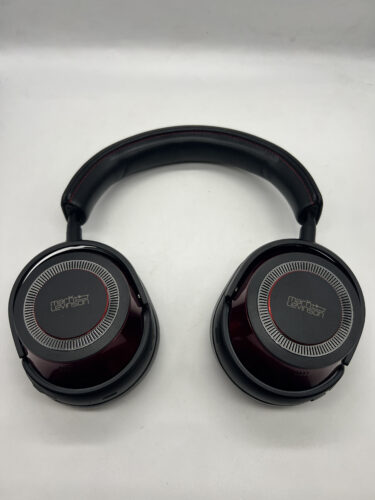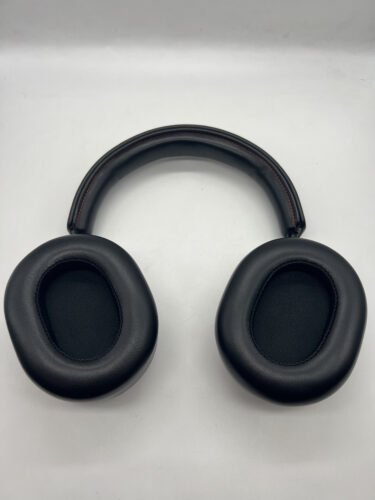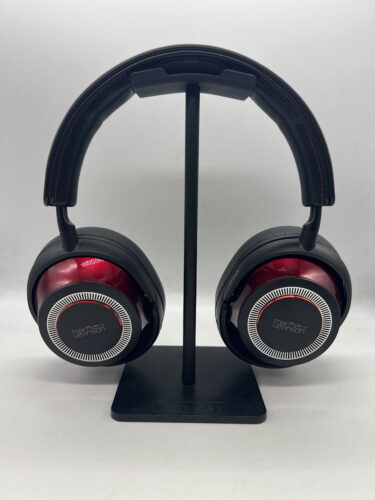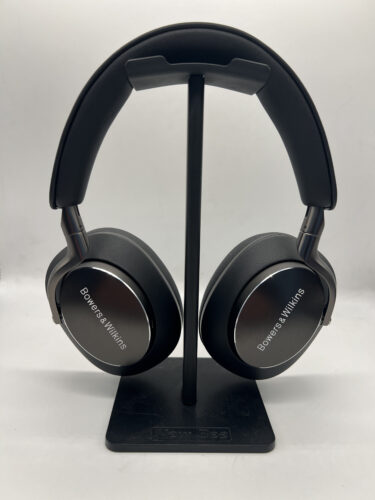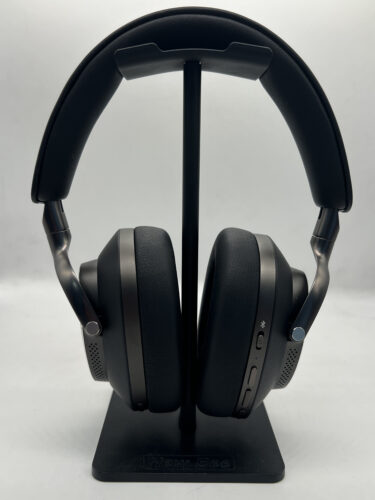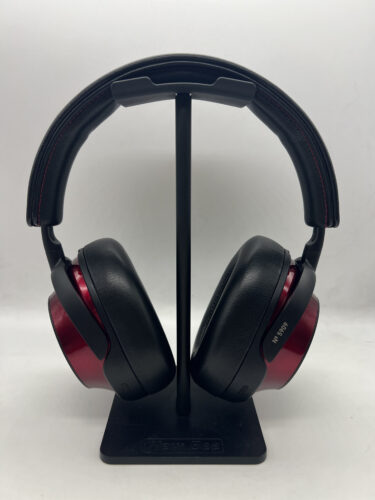Bluetooth over ear headphones are some of the best selling listening devices that are on the market. Although some enthusiasts swear by valve amps driven with sophisticated power units and their rare headphones that cost as much as used cars, it’s difficult introducing somebody to this world without the right context. Bluetooth headphones are a great way for the layman to be introduced to the audio world in an easy way. Users looking to upgrade from other bluetooth headphones into the high-end bluetooth field often want to know what the best sounding wireless device is. 2 wildly popular options are the B&W PX8 and the Mark Levinson No. 5909. Let’s find out which one stands out in the comparison review.
Look and Feel
The Mark Levinson No. 5909 is one of the most striking headphones on the market. It’s styling is reminiscent of 50s touring cars, with chrome accents, soft leather, and sloping curves. Looks are relative, but the retro-futuristic design makes these one of the best looking headphones on the market. Coming in red, black, and pewter, there are multiple options for you to get the look you want. It’s leather feels soft, but also durable and secure to wear. This is one of my favorite bluetooth devices to use day-to-day. At 355G, it’s not super light, but the construction makes it feel comfortable.
The PX8 from Bowers & Wilkins uses a more understated approach in their styling. Coming in silver, burgundy, and black, the colors are the most vibrant feature in this styling. The brushed aluminum and leather both feel smooth to the touch. At 320g per device, they’re light enough to carry around comfortably. What I’m not a big fan of is the narrow headband construction that presses the ear pads into my head. Although I didn’t find these comfortable to wear, those interested in these headphones should take an opportunity to try them out themselves.
Design
40mm dynamic drivers power the B&W PX8 limiting THD to 0.1% @1kHz/10mW. 4 ANC mics are enclosed within the aluminum construction with 2 more for phone use. They support bluetooth 5.2 and include aptX™ Adaptive, aptX™ HD, aptX™, AAC, and SBC CODECs. A quick phone conversation left me with great impressions of the call quality and the device’s internal microphones. 30 hours of playback time with 7 hours on 15 minutes of charging means that these have above average battery life.
Comparing the two, the No. 5909’s 30 hours of playtime with ANC on and 6 hours on 15 minutes of charging means that these are both pretty evenly matched in their battery features. These support Bluetooth 5.1 with LDAC, AAC, and aptX™ Adaptive CODECs. The 4-microphone array works well for ANC and calls, but I’m not sure if call quality is on the level of the B&W. The most impressive feature I noticed was how clear and effective the ANC on the No. 5909 was. Music is able to clearly come through without the strong “whoosh” effect from other brands ANC. B&W comes close, but for all the same subtlety, there’s not as much noise cancellation.
Soundstage – Bowers & Wilkins PX8 vs. Mark Levinson No. 5909 Comparison Review
The staging on the PX8 left me wanting more to put it simply. There’s some depth to sounds and the accuracy of stereo imaging comes through well. I’m able to hear the effect of sounds creeping up behind me. What isn’t very discernible is the height of noises. These are very short in their soundstage, and the rise in the drivers are somewhat lacking. I can hear subtle changes, but the sound is still very much in my head. These aren’t very wide and at this price point, I really was expecting more from the staging.
The Mark Levinson No. 5909 is a lot more worthwhile in it’s soundstage than the competition. Although they aren’t as wide as wired headphones, their staging comes pretty close to some medium-wide headphones. There is a verticality to the sound, but it’s not going to have the same holographic qualities as $1000+ open-backs. When comparing to other Bluetooth devices, these have some of the best staging out of the bunch. They’re ultra-wide compared others in the field and have some perceptual holographic qualities.
Listening Impressions
Lows
Although both these headphones lean brighter than warmer, there’s a lot to like about the low end. With the EQ settings bringing bass up, the Mark Levinson’s are able to boom loudly. At it’s stock settings, a lot of music has a subtle bass which can get driven at higher volumes. The lows were versatile on these for the specific reason that it can handle music with a lot of mixed bass. On the other hand, recorded live sets that can sometimes lack lows are easily discernible. The drivers have enough clarity to allow for more bass with the EQ. Bassheads who want their headphones to thud will be able to attenuate their mix to “thud” the way they want it to.
Right out of the box, the PX8 is going to be bassier. With EQ settings all the way up, I noticed slightly less sub-bass but the higher bass and low mid textures hold up the warmness in the sound. These will also “thud” in a similar way, but the warmth of these headphones is held up by the high bass frequencies. These have a more dramatic “V” shaped frequency response. At the same time, music with a lot of warmth can get muddy at times. This was most clear when listening to “Help on the Way”, the Grateful Dead song covered by Bela Flek. The low pitched drums, his voice, and the bass all walk over each other in a sonic sense. There’s some unwanted boxiness in this dark mix, which wasn’t present on the No. 5909. If you’re a dedicated basshead, these will still be a great option. Just not as versatile as the Mark Levinson 5909’s.
Mids
The mids on the PX8, although not the focus of the frequency response, are one of my favorite qualities. Voices and guitars are able to sing vividly without being overpowering. Simply said, I loved how clear sounds could come through. With this in mind, sounds with a lot of low-mids can be a little too much with the way the mid-frequencies are tuned on the PX8. It is rare, but the example above demonstrates how too many voices in this register can sound a little muddy without any EQ. By and large, most mixes don’t favor these frequencies. Generally, music sounds crisp while still having a great roundness in the low-mids.
Mark Levinson’s No. 5909 are very similar in the mid quality, just with a little less low mids. Overall, voices in the mid-range have even better clarity and crispness. Sounds are a little more glassy because of the reduced low-mid quality. Cymbals don’t have too much attack on them to be sibilant, but there’s enough shine that it’s palpable listening them clash. Overall, I want to say that the 5909’s mids are more versitile than the PX8. On the other hand, it’s difficult to EQ them to sing in the same way that the PX8 can. There’s slightly less sustain out of distorted guitars, but it’s not much of a drawback considering how close they can get.
Highs
The No. 5909 have a great treble range to them once you do a simple trick to make them a little tamer. EQing the frequencies around 7kHz by about 3-5 dB evens out the treble response of these significantly. It feels like there’s a huge bump in this range that feels slightly unnatural. I didn’t do this in the app, but through my device in the Roon player. For a $1000 headphone, I want a multi-band eq specifically for this reason. Sony and Sennheiser are able to do this to their Bluetooth headphones priced in the mid $300 range. Nevertheless, there’s way less harshness to sounds once you make this slight adjustment. Before I made this shift, I noticed too much airiness in higher-pitched sounds.
Right out of the gate, these are bright headphones without being brittle. There’s a great amount of sharpness in sounds without sounding sibilant. Although I’m sensitive to highs, I didn’t experience much fatigue in this range even after hours of listening. Cymbals, high pitched voices, and airy synths all have a great shine to them with no EQing. Considering there was no doctoring I had to do on these, the PX8 wins the battle for highs in the comparison review.
Summary
Although both headphones have qualities that make them very enticing options, I have to choose the Mark Levinson No. 5909 for this comparison. Despite having an underwhelming app and too much airiness for me, they’re ultimately comfortable and have a great soundstage. The lack of comfort and soundstage of the PX8 means that although the tuning was very pleasant from these headphones, I couldn’t see myself putting them on everyday. If you’re thinking about getting a pair of PX8s, I don’t think you’ll be disappointed. However if you’re not sold and could bring your budget up, I would definitely consider the No. 5909.
Get the No. 5909 and the PX8 at Audio 46
MAJORHIFI may receive commissions from retail offers.



